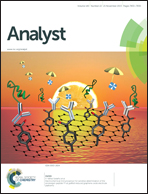A biomimetic enzyme modified electrode for H2O2 highly sensitive detection†
Abstract
An efficient catalyst based on artificial bionic peroxidase was synthesized for electrocatalysis. A poly(ethyleneimine)/Au nanoparticle composite (PEI-AuNP) was prepared and it was then linked to hemin via a coupling reaction between carboxyl groups in hemin and amino groups in PEI without the activation of a carboxyl group by carbodiimide. Fourier transform infrared (FTIR) spectroscopy verified the formation of amido bonds within the structure. The presence of AuNPs contributed greatly in establishing the amido bonds within the composite. Transmission electron microscopy (TEM) and UV-visible spectroscopy were also used to characterize the PEI-AuNP–hemin catalyst. PEI-AuNP–hemin exhibited intrinsic peroxidase-like catalytic activities. The PEI-AuNP–hemin deposited on a glass carbon electrode had strong sensing for H2O2 with a well-defined linear relationship between the amperometric response and H2O2 concentration in the range from 1 μM to 0.25 mM. The detection limit was 0.247 nM with a high sensitivity of 0.347 mA mM−1 cm−2. The peroxidase-like catalytic activity of PEI-AuNP–hemin is discussed in relation to its microstructure. The study suggests that PEI-AuNP–hemin may have promising application prospects in biocatalysis and bioelectronics.


 Please wait while we load your content...
Please wait while we load your content...